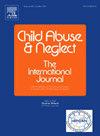Beyond neonaticide: A forensic typology of suspicious perinatal deaths in South Korea (2015–2021)
IF 3.4
2区 心理学
Q1 FAMILY STUDIES
引用次数: 0
Abstract
Background and objective
Crisis pregnancies can lead to a spectrum of fatal outcomes, yet traditional research, focused narrowly on neonaticide and constrained by the “born-alive principle,” often overlooks concealed stillbirths and forensically ambiguous cases. This study applies the broader framework of Suspicious Perinatal Death (SPD) to a national South Korean forensic dataset (2015–2021) to identify epidemiological patterns and empirical typologies during a period of significant sociopolitical change.
Participants and setting
From all perinatal autopsies (N = 230) at South Korea's National Forensic Service, 138 cases met criteria for SPD (fetal death ≥24 gestation or neonatal death within ≤24 h under suspicious circumstances).
Methods
In this retrospective study, 64 variables were coded from forensic and investigative records. After feature selection (Boruta algorithm) and outlier removal, Partitioning Around Medods (PAM) cluster analysis on 132 cases was used to derive typologies.
Results
Three distinct typologies emerged: ‘Adolescent-Dependent’ (n = 42, 31.8 %), ‘Isolated Single-Mother’ (n = 36, 27.3 %), and ‘Socially Vulnerable-External Discovery’ (n = 54, 40.9 %). A critical temporal trend was identified: confirmed neonaticide cases declined by 91.7 %, while non‑neonaticide SPD cases (e.g., induced stillbirths) increased by 150 %. Live birth status remained forensically indeterminate in 29.0 % of cases.
Conclusions
The SPD framework reveals that perinatal deaths in South Korea are not simply decreasing but are transforming in method, influenced by shifting legal and medical landscapes. The identification of distinct, evidence-based typologies underscores the need for a paradigm shift from punitive responses toward tailored, preventive public health interventions.
超越杀新生儿:韩国可疑围产期死亡的法医类型学(2015-2021)
背景与目的危重妊娠可导致一系列致命的后果,然而传统的研究,狭隘地关注于新生儿杀婴,并受到“活产原则”的限制,往往忽视了隐藏的死产和法医上模棱两可的病例。本研究将可疑围产期死亡(SPD)的更广泛框架应用于韩国国家法医数据集(2015-2021),以确定重大社会政治变革时期的流行病学模式和经验类型。在韩国国家法医服务中心进行的所有围产期尸检(N = 230)中,138例符合SPD标准(胎儿死亡≥24妊娠期或可疑情况下≤24小时新生儿死亡)。方法采用回顾性研究方法,对法医和调查记录中的64个变量进行编码。在进行特征选择(Boruta算法)和离群值去除后,对132个案例进行分区围绕方法(PAM)聚类分析,得出类型。结果出现了三种不同的类型:“青少年依赖型”(n = 42, 31.8%),“孤立的单亲母亲”(n = 36, 27.3%)和“社会脆弱性-外部发现型”(n = 54, 40.9%)。发现了一个关键的时间趋势:确认的杀新生儿病例下降了91.7%,而非杀新生儿的SPD病例(例如引产死胎)增加了150%。在29.0%的病例中,活产状况在法医上仍不确定。结论SPD框架显示,受法律和医疗环境变化的影响,韩国围产期死亡人数不仅在减少,而且在方法上也在发生变化。明确以证据为基础的不同类型强调了从惩罚性应对向量身定制的预防性公共卫生干预模式转变的必要性。
本文章由计算机程序翻译,如有差异,请以英文原文为准。
求助全文
约1分钟内获得全文
求助全文
来源期刊

Child Abuse & Neglect
Multiple-
CiteScore
7.40
自引率
10.40%
发文量
397
期刊介绍:
Official Publication of the International Society for Prevention of Child Abuse and Neglect. Child Abuse & Neglect The International Journal, provides an international, multidisciplinary forum on all aspects of child abuse and neglect, with special emphasis on prevention and treatment; the scope extends further to all those aspects of life which either favor or hinder child development. While contributions will primarily be from the fields of psychology, psychiatry, social work, medicine, nursing, law enforcement, legislature, education, and anthropology, the Journal encourages the concerned lay individual and child-oriented advocate organizations to contribute.
 求助内容:
求助内容: 应助结果提醒方式:
应助结果提醒方式:


